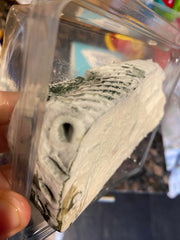In as many ways as possible, we've borrowed characteristics from dairy cheese to bring you familiar tastes and textures that you know and love. One of the ways we do this is by adapting the ageing/maturation process for mould ripened cheeses, and by using moulds/cultures - like penicillium roqueforti in our award-winning plant-based Blue.
 If you purchase our Blue via a stockist, it'll probably have been sliced and packed about a week ago (give or take) so you might get home and notice a little white mould growing. We thought we'd explain that so you know what you're looking at! Essentially, to keep the cheese 'alive' (which we do to make it delicious, like similar dairy Blues) we had to design packaging that allows a very small amount of oxygen to wriggle through and into the cheese, the result is that there is a small amount of continued development of the Blue, which often appears white at the offset. It's okay, expected, and won't take away from the taste, in fact - it might even make it more distinct. Much like with comparable dairy cheeses, it's quite alright to lob a little off and tuck right in!
If you purchase our Blue via a stockist, it'll probably have been sliced and packed about a week ago (give or take) so you might get home and notice a little white mould growing. We thought we'd explain that so you know what you're looking at! Essentially, to keep the cheese 'alive' (which we do to make it delicious, like similar dairy Blues) we had to design packaging that allows a very small amount of oxygen to wriggle through and into the cheese, the result is that there is a small amount of continued development of the Blue, which often appears white at the offset. It's okay, expected, and won't take away from the taste, in fact - it might even make it more distinct. Much like with comparable dairy cheeses, it's quite alright to lob a little off and tuck right in!Some of our cheese lovers (connoisseurs you might say!) choose to leave their wedge in the fridge for as long as possible - so that the ageing process continues for as long as they can hold out..

We spotted this ^ convo in a vegan facebook group, specifically referring to our beloved Blue! Hope this explains any queries or questions you might have, but if you want to run anything by us - you can always drop us an email (support@honestlytasty.co.uk) or slide into our DMs on any social platform.